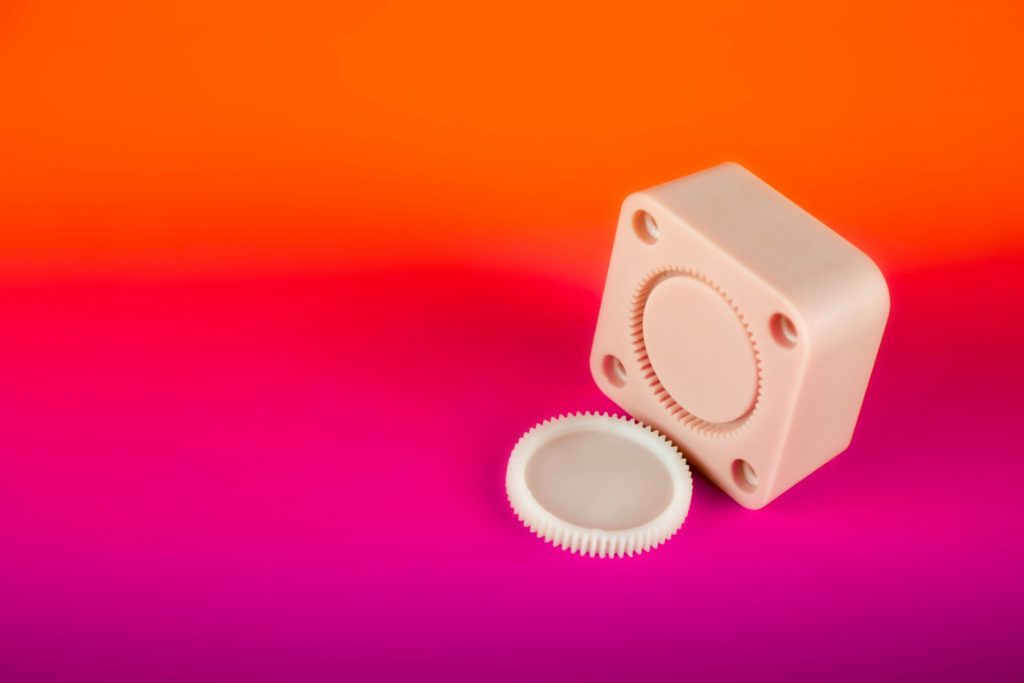Upon acquiring the Functional Materials unit of Royal DSM, Covestro has been busy developing new 3D printing materials for a variety of applications. These range from TPU for insoles to recycled polycarbonate from water bottles and recycled PET for pellet printing. At RAPID + TCT 2021, the firm announced yet another new material, this time targeted at the injection molding industry, as well as a new software partnership with ParaMatters designed to overcome anisotropy in printed objects.
With Desktop Metal subsidiary EnvisionTEC, the company announced that it had injection molding in its sights with a material-and-printer solution capable of 3D printing tooling for injection molding. The bundle is a combination of Covestro’s e-PerFORM digital light processing (DLP) material optimized for EnvisionTEC’s Perfactory P4K series DLP printer. The combination is said to offer the dimensional stability and minimal warpage required for the injection molding industry.

Covestro’s new Somos® PerForm HW resin enables efficient low-volume production using DLP and LCD 3D printing. © Covestro
The resulting molds were tested with “key molding institutes to validate the material’s performance” and completed mold trials suggests that e-PerFORM offers the stiffness and temperature characteristics necessary for the application. Covestro suggests that the new material is similar to Somos PerFORM for stereolithography resin for injection molding tooling.
The French Federation of Plastics and Composites, Polyvia, was one of the testing partners. Guy Chrétien, Process project manager at Polyvia, confirmed the suitability of the material for injection molding: “We tested the new e-PerFORMTM resin printed on the EnvisionTEC P4K printer and demonstrated that we could achieve very good results in part fidelity and in the number of shots molded in both polypropylene and glass-reinforced nylon. With the cost effectiveness and print speed of the P4k platform and with the properties of the e-PerFORMTM resin, this creates additional opportunities for rapid tooling.
Hugo da Silva, Head of Additive Manufacturing at Covestro commented: “By working closely with our partner EnvisionTEC, we developed a material that meets critical needs voiced in the market: improved dimensional stability and minimal warpage for optimal functionality. The validation and proven solution with their P4K printers will help accelerate the adoption of additive manufacturing of injection mold tooling.”
This has been a target application of 3D printing for some time, but more in terms of hypotheticals and one-off use cases. However, Phoenix Contact subsidiary PROTIQ offers a service for the design and production of 3D printed molds. Fortify has made printed tooling one of its main areas of focus and ExOne, another subsidiary of Desktop Metal, has recently announced a suite of printed tooling solutions, including for injection molding.
While 3DPrint.com Executive Editor Joris Peels has questioned Fortify’s targeting of this segment, I believe it’s one that is ripe for disruption. As PROTIQ has demonstrated, molding tools can be optimized in a variety of ways that make the process faster, by causing them to cool off more quickly and by reducing their weight. While PROTIQ used metal molds, there are possibilities to improve plastic molds as well.
Covestro has also partnered with ParaMatters to develop software for anisotropic materials, specifically for filament extrusion with fiber-reinforced materials. The CogniCAD tool makes it possible to optimize models based on the way material is deposited and reinforcement fibers are oriented to create the best toolpath for the 3D printer. This includes such factors as materials, weight, and cost, as well as part performance. CogniCAD seems to be meant for printers using chopped fiber reinforcement materials, which are made by numerous manufacturers.
The software was tested by “leading” aerospace users, including Airbus subsidiary Composite Technology Center / CTC GmbH, on multiple filament extrusion printers.
Jorne Driezen, Scientific Researcher at CTC stated: “The anisotropic behavior of 3D printed parts with fiber reinforcement allows us to gain weight potentials compared to conventional approaches. With our pre-existing methods of working, the design and sizing of 3D printed parts require multiple tools. ParaMatters anisotropic optimization capabilities allow us to combine multiple stages into a single step, enabling us to cut development times by orders of magnitude and create stronger and more light weighted components.”
The beta version of the tool is available now, with users and filament-based extrusion providers able to join the program to quality and certify their systems.
Subscribe to Our Email Newsletter
Stay up-to-date on all the latest news from the 3D printing industry and receive information and offers from third party vendors.
You May Also Like
Further Understanding of 3D Printing Design at ADDITIV Design World
ADDITIV is back once again! This time, the virtual platform for additive manufacturing will be holding the first-ever edition of ADDITIV Design World on May 23rd from 9:00 AM –...
3D Printer Maker EVO-tech Reborn as NEVO3D — Once More With Feeling
EVO-tech was a 3D printing service and original equipment manufacturer established in 2013 and based in Schörfling am Attersee, Austria. The company produced high-quality material extrusion systems featuring linear bearings,...
3D Systems Brings 3D Printed PEEK Cranial Implant to the U.S. with FDA Clearance
For more than 10 years, 3D Systems (NYSE:DDD) has worked hand-in-hand with surgeons to plan over 150,000 patient-specific cases, and develop more than two million instruments and implants from its...
CDFAM Returns to Berlin for Second Annual Symposium
The second CDFAM Computational Design Symposium is scheduled for May 7-8, 2024, in Berlin, and will convene leading experts in computational design across all scales. Building upon the first event...































